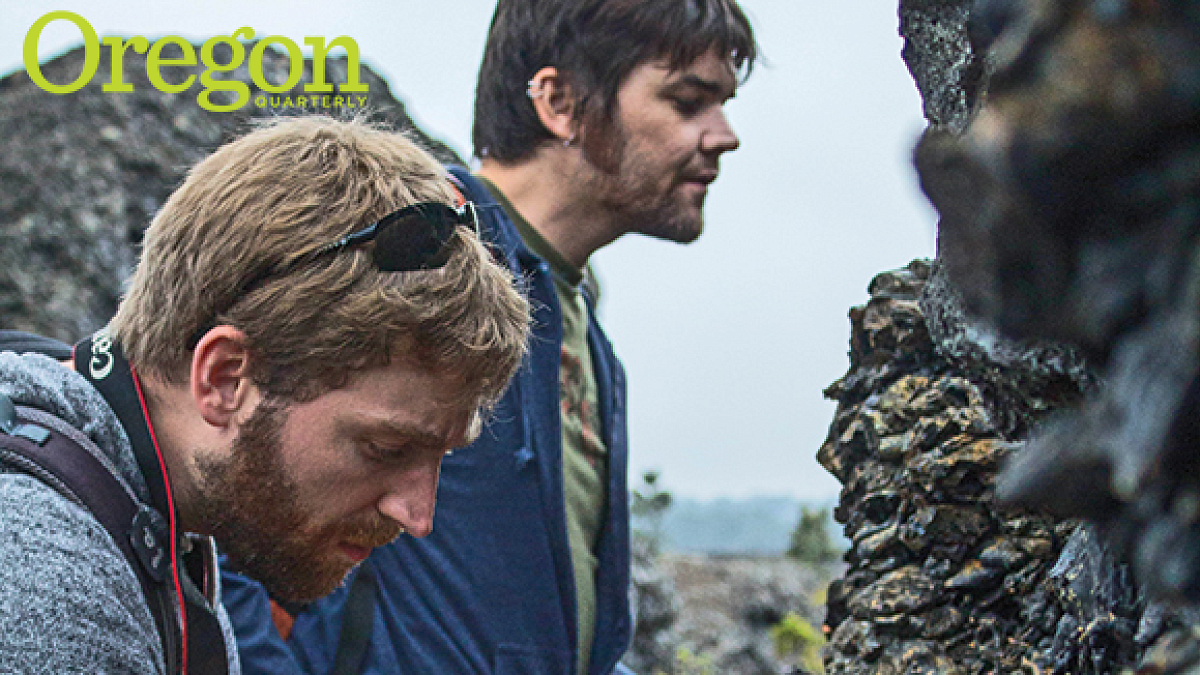Almost smack-dab in the middle of Oregon, Newberry Volcano rises a comparatively modest 7,989 feet from the high desert plateau southeast of Bend.
Any number of the region’s peaks look down on Newberry. Even Mount Saint Helens, despite blowing its top in 1980, has a few hundred feet on the volcano named for geologist John Strong Newberry, who explored central Oregon in 1855.
But what Newberry lacks in height it more than accounts for in breadth. Covering an area equal to the size of Rhode Island, Newberry has a total volume of 120 cubic miles, making it the largest in Oregon and Washington. And Newberry is primed to let it go.
“To blow or flow, that is the question,” says Thomas Giachetti, a recent addition to the UO’s volcanology team and a specialist in the dynamics of magma, the subterranean molten rock that can fuel an explosion.
Newberry is one of four Oregon volcanoes with a high potential for a major eruption, and Giachetti is trying to determine whether that release will be of the flowing, oozing variety or the explosive, blow-the-lid-off-the-place kind.
He’s in the prediction game—he will study past volcanic activity at Newberry in the hope of learning more about what makes a volcano blow. Forecasting an eruption is one of the great quests in volcanology, and it’s an area in which the UO’s Department of Earth Sciences is expanding its expertise.
Thanks to a $10 million gift from UO benefactors Gwen and Charles Lillis, PhD ’72, two additional faculty members are scheduled to join volcanology in 2018.
One hire will be an expert in using instruments that monitor subtle changes in land—such as the bulging of a volcano—that can precede volcanic activity. The other new faculty member will use high-powered computers to build models that explore what happens to the ash, superheated gases, and lava fragments that spew from eruptions. This information will be used to minimize volcanic impacts on people and planes, the latter being vulnerable to airborne ash plumes.
The last thing you want to do when a volcano becomes active, says Paul Wallace, head of earth sciences, is try to play catch-up.
“Many volcanoes are dormant and then rumble back to life. We need to be able to read the warning signs accurately,” he says. “The Lillis gift will allow us to hire people whose work will be focused on using new kinds of technology to do that. We couldn’t be more grateful for their generosity and support of our research.”
That technology includes drones, which can be flown over active volcanoes to provide the view from above, or sent through an ash cloud to measure temperature, humidity, and thermal data in real time.
The Lillis gift also provides for an experimental volcanology lab that will focus on the dangerous mix of hot gases, ash, pumice, and rock fragments that are ejected during an explosive eruption. The lab will include equipment that mimics the processes that occur as magma transforms into volcanic ash and pumice during major eruptions.
Wallace says the new research programs “will allow us to focus on processes occurring in explosive volcanic eruptions, including the transport of ash and pumice through the atmosphere.”
With Giachetti’s arrival last year, Wallace has seen the volcanology research team grow to six, a high point since volcanologist Alexander McBirney established a major volcanology research program at Oregon in 1965. In addition to the new funded positions, two others are planned over the long-term—one will try to harness volcanoes’ intense heat to generate geothermal energy and the other will examine the effects of large eruptions on climate and biodiversity.
It makes sense to have a robust research portfolio in volcanology, Wallace says, given that our region is home to nearly a dozen volcanoes that the US Geological Survey has deemed worthy of close monitoring for possible eruptions, including Mount Hood, the Three Sisters, and Crater Lake.
The state’s geological wonders made for a striking backdrop to a major conference of international volcanologists in August. Held in Portland and sponsored in part by the UO, the International Association of Volcanology and Chemistry of the Earth’s Interior brought 1,200 of the world’s top earth scientists to Oregon for a quadrennial gathering, last held in the US in 1989.
Attendees got up-close-and-personal with the state’s volcanic attractions during trips to sites such as Crater Lake and Mount Hood. The event also provided Wallace with the opportunity to do a bit of informal recruiting—he was able to discuss not just the research that his team is doing today, but what lies ahead.
“It was a great chance to show our research to the world,” Wallace says.
Giachetti, for example, studies the deposits of past eruptions to reconstruct the periods during which a volcano erupted violently or more benignly. He’ll soon do this work at Newberry—although, given his love of the outdoors and all its volcanic wonders, he hesitates to call it “work.”
“When you are a volcanologist, you love nature,” Giachetti says. “You want to understand things and be able to share them.”
—By Jim Murez, University Communications


